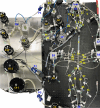Development of an Anatomy-Mimicking, Wave Transport-Preserving Mock Circulation Loop for Evaluating Pulsatile Hemodynamics as Supported by Cardiovascular Assist Devices
- PMID: 40261578
- PMCID: PMC12367835
- DOI: 10.1007/s13239-025-00785-y
Development of an Anatomy-Mimicking, Wave Transport-Preserving Mock Circulation Loop for Evaluating Pulsatile Hemodynamics as Supported by Cardiovascular Assist Devices
Abstract
Objective: Assessing circulatory hemodynamics in-vitro is crucial for cardiovascular device design before in-vivo testing. Current mock circulation loops (MCLs) rely on simplified, lumped-parameter hydraulic representations of human circulation. There is a need for a more sophisticated MCL that can accurately represent the human circulatory physiology and allow for critical assessment of device-supported hemodynamics.
Methods: An anatomy-mimicking MCL design guided by one-dimensional flow models has been developed, using tree-like arterial casts to create a complex system. The MCL comprises cardiac simulators, systemic circulatory subsystems consisting of 46 connected arterial casts, and lumped venous and pulmonary components. A parameter tuning process was also developed to ensure that the simulated MCL baselines are consistent with targeted healthy or heart failure scenarios.
Results: Blood pressure and flow waveforms in the thoracic aorta, upper and lower limb arteries and abdominal organs (kidney, liver, spleen, etc.) were reproduced and validated against published data. Complex afferent and efferent flows in cerebral circulation and phasic coronary flow subjected to myocardial compression effect were replicated with precision. Pulse wave behavior was authentically generated and compared favorably to the published in-vivo and in-silico results.
Conclusion: This wave transport-preserving MCL is able to simulate pulsatile human circulatory hemodynamics with sufficient detail and accuracy. Complex cardiovascular device-intervened hemodynamics in large arteries and end organs can be systematically assessed using this new MCL, potentially contributing to a rapid and accurate in-vitro simulation to help advance device design and functional optimization.
Keywords: Circulatory assist device design; In-vitro hemodynamic testing; Mechanical circulatory support; Mock circulation loop; Pulsatile flow physiology.
© 2025. The Author(s).
Conflict of interest statement
Declarations. Conflict of Interest: Lu, PJ is the Founder and CEO of 3R Life Sciences and was the Professor of Aeronautics and Astronautics and Director of Heart Science Research Center of National Cheng Kung University, Taiwan during the initial design and testing period of the mock circulation loop. Tsui, S is the chief medical officer (honorary) of 3R Life Sciences. Chan, MY and Shen, TT have management/lead roles in 3R Life Sciences. Chang, JC has no conflicts of interest to disclose. Ethical Approval: Not applicable Consent to Participate: Not applicable Consent to Publish: Not applicable
Figures










References
-
- Cappon, Wu. T., T. Papaioannou, X. Du, P.-L. Hsu, and A. W. Khir. Mock circulatory loops used for testing cardiac assist devices: a review of computational and experimental models. Int. J. Artif. Organs. 44:793–806, 2021. - PubMed
-
- Timms, D., M. Hayne, K. McNeil, and A. Galbraith. A complete mock circulation loop for the evaluation of left, right, and biventricular assist devices. Artif. Organs. 29:564–572, 2005. - PubMed
-
- Timms, D. L., S. D. Gregory, N. A. Greatrex, M. J. Pearcy, J. F. Fraser, and U. Steinseifer. A compact mock circulation loop for the in vitro testing of cardiovascular devices. Artif. Organs. 35:384–391, 2010. - PubMed
-
- Koenig, S., G. Pantolos, K. Gillars, D. Ewert, K. Litwak, and S. Etoch. Hemodynamic and pressure-volume responses to continuous and pulsatile ventricular assist in an adult mock circulation. ASAIO J. 50:15–24, 2004. - PubMed
MeSH terms
Grants and funding
LinkOut - more resources
Full Text Sources

